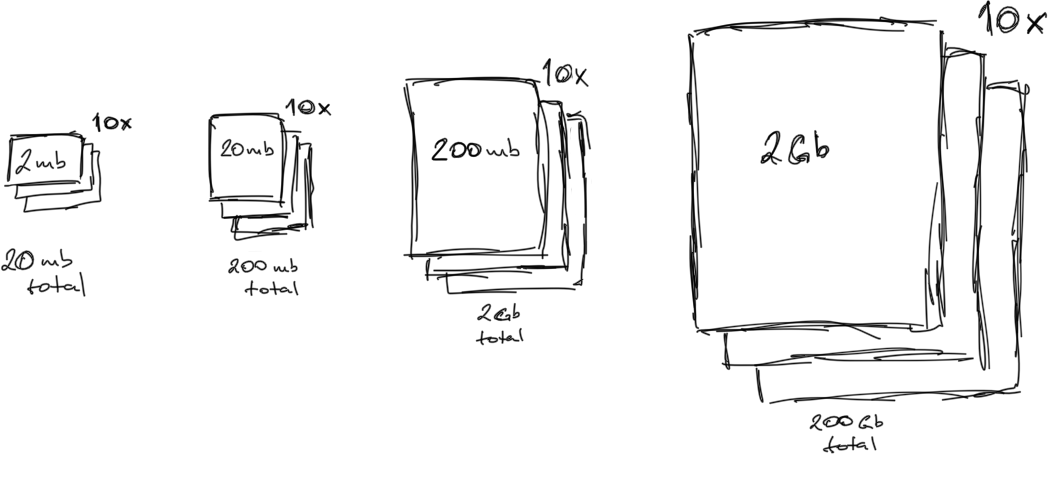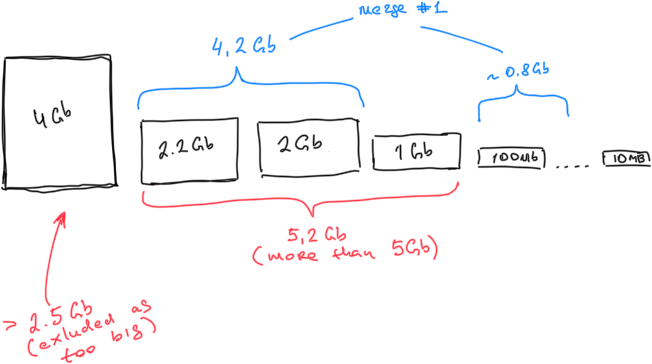Elasticsearch: How to avoid index throttling, deep dive in segments merging
- modified:
- reading: 8 minutes
This blog post is written based on source code of Elasticsearch 5.5.0 and Lucene 6.6.
If you are managing Elasticsearch cluster it is very important to understand what are the segments in the index, why and when they are getting merged, and what is the right configuration.
If your Elasticsearch cluster is fairly big, default configuration might not work for you. Not sure why the
documentation for the Merge Policy is gone from
Index Modules,
but you can find it in
source code (MergePolicyConfig.java).
At the bottom
you can find really important note about the max_merged_segment, which is set to 5gb by default.
Note, this can mean that for large shards that holds many gigabytes of data, the default of
max_merged_segment(5gb) can cause for many segments to be in an index, and causing searches to be slower.
So what is the many gigabytes of data? Let’s try to answer on this question.
First I would highly recommend you to look on
Visualizing Lucene’s segment merges by Michael McCandless.
If you are not familiar with Lucene you should also look into
Elasticsearch from the Bottom Up.
The third video in first link presents TieredMergePolicy. It is the merge policy you should be most interested in.
All the other policies were deprecated in Elasticsearch 1.6 and removed in Elasticsearch version 2.0. In the article mentioned above
you will find very good explanation on how TieredMergePolicy works.
What helped me more, when I looked in the source code of Lucene implementation of method TieredMergePolicy.findMerges. That and looking on default configuration of Elasticsearch helped me to understand what to expect.
Back to the article mentioned above
TieredMergePolicy first computes the allowed “budget” of how many segments should be in the index, by counting how many steps the “perfect logarithmic staircase” would require given total index size, minimum segment size (floored), mergeAtOnce, and a new configuration maxSegmentsPerTier that lets you set the allowed width (number of segments) of each stair in the staircase. This is nice because it decouples how many segments to merge at a time from how wide the staircase can be.
Let’s look on how that is implemented
First
we get a collection segments infosSorted, sorted in descending order by size.
Collections.sort(infosSorted, new SegmentByteSizeDescending(writer));
Block calculates total size of the index (sum of all segments) and size of the smallest segment
long totIndexBytes = 0;
long minSegmentBytes = Long.MAX_VALUE;
for(SegmentCommitInfo info : infosSorted) {
final long segBytes = size(info, writer);
// ... skipped ... //
minSegmentBytes = Math.min(segBytes, minSegmentBytes);
// Accum total byte size
totIndexBytes += segBytes;
}
Now we have two variables, totIndexBytes is the size of all indices and minSegmentBytes is the minimum segment size.
Next
we exclude all segments larger than max_merged_segment/2.0 (with default value 5gb it is 2.5gb)
int tooBigCount = 0;
while (tooBigCount < infosSorted.size()) {
long segBytes = size(infosSorted.get(tooBigCount), writer);
if (segBytes < maxMergedSegmentBytes/2.0) {
break;
}
totIndexBytes -= segBytes;
tooBigCount++;
}
Seem like this loop can be easily combined with previous one. PR#219.
Using value of floor_segment (default is2mb) if the smallest segment is less than that
minSegmentBytes = floorSize(minSegmentBytes);
Next block is very important, it calculates number or allowed segments. The number which triggers the merge, when the number of segments is more than that
long levelSize = minSegmentBytes;
long bytesLeft = totIndexBytes;
double allowedSegCount = 0;
while(true) {
final double segCountLevel = bytesLeft / (double) levelSize;
if (segCountLevel < segsPerTier) {
allowedSegCount += Math.ceil(segCountLevel);
break;
}
allowedSegCount += segsPerTier;
bytesLeft -= segsPerTier * levelSize;
levelSize *= maxMergeAtOnce;
}
int allowedSegCountInt = (int) allowedSegCount;
Taking default configuration with floor_segment equal to 2mb and assuming that you have segment with size lower or
equal to floor_segment we can estimate the allowedSegCountInt to be around 40 segments and our perfect logarithmic staircase
should look like

Some observations from above:
- Changes to the
floor_segmentor index refresh can cause the valueminSegmentBytesbe very high, which will makeallowedSegCountIntsmaller and that can cause a lot of scheduled merges. - Changing the value of
segments_per_tiercan also significantly change on how often you will see segments to be merged in index. - The code above uses
max_merge_at_onceto reserve space for the tier (level) and usessegments_per_tierto set how many segments is allowed for this tier. (both set to10by default in Elasticsearch).
Only
if number of eligible segments more than allowedSegCountInt, lucene proceeds with finding candidates for merges
if (eligible.size() > allowedSegCountInt) {
// ...
}
Where eligible
is the list of all segments with size less than max_merged_segment/2.0 and has not been included in any merges yet.
The code
under this if statement trying to find the possible combination of segments to include in merges which will bring
eligible.size() under allowedSegCountInt.
The algorithm is simple, it starts from the largest segment and trying to find N segments (where N < max_merge_at_once),
which in merge will result segment with size less than max_merged_segment. This is a reason, why actually the
perfect logarithmic staircase should not happen, because this merge policy does not look for how to merge together
smallest segment, but actually trying to find how to merge the largest segments first.
This is an example

- Segment with size
4.2Gbwill be excluded as too big (size more thanmax_merged_segment/2.0). - First segment considered for merge will be the one with size
2.2Gb. This segment can be merged with the segment with size of2gb, but not with2gband1gbat the same time, so it will skip1gbsegment and start looking for smaller segments which will result in size of close to5gbor smaller (max_merged_segment), but number of segments in this merge should not be larger thanmax_merge_at_once(10by default). - If number of eligible segments still more than
allowedSegCountIntthe next merge will be constructed from segment of size1gband segments which are not included in previous merge (again considering two constraintsmax_merged_segmentandmax_merge_at_once).
Some observations from this code:
- Segments larger than
max_merged_segment/2.0will not be included in any merge, even if the percentage of deleted documents is overexpunge_deletes_allowed(10%by default). If you will end up with a lot of segments with size more thanmax_merged_segment/2.0and you constantly deleting documents from them - their space will never be reclaimed. You will need to perform force merge or change the configuration. - To previous point. If index has segment with size lower than
max_merged_segment/2.0, which cannot be merged with any other segments (I would assume very uncommon situation) but has more thanexpunge_deletes_allowedof deleted objects - this is the time when the deleted documents can be expunged if none of other merges will be find. - If you have a segment with the size of
max_merged_segment/2.0 - 1byteit will never be merged with any segment and never be excluded from theallowedSegCountInt. I would assume that this is a very rarely case. I have asked to be sure that this is a known issue. - Now I know why regular reindexing of all data can help with making searches faster. With
TieredMergePolicyit is very likely that segments will be merged not in sequence order (see my example above). This can be a problem if terms change with the time. Because of that segments need to store terms from various periods. In my example above if4Gband2.2Gbare the segments with onlyJanuarydata, it is very likely that these segments will be merged with some small segment at the end, for example last segment of size10mb, which holdsDecemberdata. - Because of the point from above - if you have time series data - using indices with time postfixes (
YYYY-mm-DD) should be beneficial.
Now it is much clear for me how segments are getting merged in Lucene. Let’s come back to the Elasticsearch and look on
index throttling. Index throttling happens in EngineMergeScheduler.beforeMerge.
It happens when TieredMergePolicy.findMerges returns more merges than the value of index.merge.scheduler.max_merge_count.
The value of max_merge_count is defined in MergeSchedulerConfig.
By default this value is set to index.merge.scheduler.max_thread_count + 5,
where max_thread_count = Math.min(4, numberOfProcessors / 2).
This value can be changed dynamically as any other index setting (but for some reason it is not documented)
curl -XPUT http://localhost:9200/*/_settings -d'{
"index.merge.scheduler.max_merge_count": 100
}'
If you are planning to play with the configuration for merge policy I would highly recommend you to change this to higher value than default, that will help you to avoid index throttling.
What else can cause index throttling? It really depends. First, very obvious is enabled throttling for merges
indices.store.throttle.type or very low value of indices.store.throttle.max_bytes_per_sec. Seems like in Elasticsearch
6.0 these settings will be removed,
so merges will never be throttled.
To find what else can cause index throttling I would recommend to look on current sizes of segments, use
the algorithm from the TieredMergePolicy, predict what kind of merges will be scheduled. That should help you
to answer the question. Can be that you have too many small segments or maybe too many large segments.